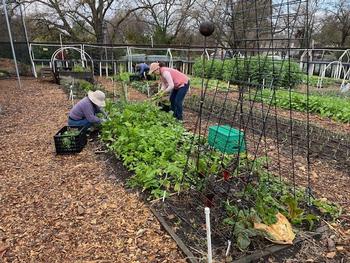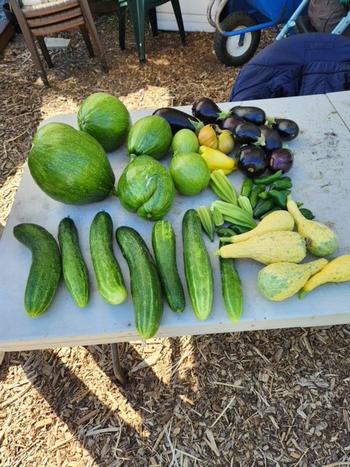The Latest Dirt - March 2024
Family Garden Bed…The Story
By Jan Manns
The Family Garden Bed at Our Garden Walnut Creek was initiated six years ago when UC Master Gardeners Monika Witte and Janet Miller proposed dedicating one of the 30 garden plots as a tangible example of what a family can accomplish in their own backyard. The idea mushroomed.

The heavy hitters are sweet potatoes, squash, onions, and tomatoes. One year, an experiment with corn took up a full square yard of space on the eastern corner but provided a surprisingly low yield while requiring lots of water and robbing the soil of nitrogen. Space is always being made for flowers, such as Marigolds, Coneflowers, and Pansies, to attract pollinators.
Once again, the plan evolved when Suzanne Miller, the current lead for this pilot plot, added her signature flair with an enhanced emphasis on edible greens that produce quite nicely during colder months. Now, we have an “antioxidant” section featuring beets and leafy greens such as kale and spinach. We have an “Asian” greens section featuring tatsoi and bok choy.
With the first signs of spring tickling our gardening senses, the Family Garden Bed Team is beginning to propagate. We are starting with one seed per tiny cell in plastic six-packs. We begin with lettuce, bok chow, tatsoi, and kale…, which will be planted in the ground in four to six weeks. Next, we will propagate squash, melons, cucumbers, and other summer crops. All this is according to the master plan set down on a color-coded Excel file that directs our weekly adventures.
Around and about us hums the daily activity of volunteer UC Master Gardeners who are “potting up” in preparation for the Great Tomato Plant Sale in April. Family Garden Bed seedlings are often plucked from these propagation efforts as well.

So, primarily, we have stuck to propagating and planting the seedlings when they are big enough to tolerate less watering. And then, you have the rodents…another story…another time.
Now, let’s turn to what we have learned and love to share with visitors to Our Garden, including the Growing Gardeners and the folks who stroll by the Family Garden Bed on Wednesdays, following the seasonal presentations under the Oak Tree.
Location, Location, Location: Do chart the sun that shines on the proposed plot. Summer crops, such as tomatoes, squash, beans, melons, and peppers, all need at least six hours of sun. When charting the sun, one notices that it tracks along the southern part of the sky, regardless of season. Garden beds are best placed lengthwise from east to west to take advantage of that trajectory.
Plant taller plants so they do not shade shorter plants.
Soil and Water: If the soil is heavy and clayish…amend it. Exclusively, clay soil can retain too much water. If the soil is sandy...amend it. Sandy soil can allow water to flow through too quickly. You want something in-between that is a “loam” texture. Use compost (your own if possible) and organic fertilizers to help build a healthy soil environment for plants over the long haul. How often you water will depend on the time of year, rainfall, how the soil retains water, and how deep the roots grow.

Technique: We “chop and drop” and practice “no-till” gardening. When we chop and drop, we cut down and do not dig up the roots, leaving that healthy microbiome in place. When we talk about “no-till” gardening, this means leaving the soil in place and just working in the nutrients and amendments gently season after season. With this method, there is no more rototilling.
When we apply this method to the Family Garden Bed, which is actively farmed all year ‘round, we have to be extra careful to add the right mix of compost and fertilizer to keep the soil healthy.
Rotation, Rotation, Rotation: With only one garden bed to work with, just as this may be in your backyard, rotation can be a real challenge. The number one concern will be your tomatoes. Because certain fungi that tomato plants can develop can stay in the soil, these are the plants that most require attention to rotation.
One other thought is that all of our garden plants are sucking up the nitrogen. It will always be essential to ensure the nitrogen levels are what they need to be. Accomplish this by planting cover crops, such as fava beans, which set the nitrogen in the soil. You can also add organic fertilizer.
Three Sisters: We learned a lot about our 5’x20’ Family Garden Bed when we decided to employ the Three Sisters, also called interplanting. The system plants corn, pole beans and squash on the same hill. The corn grows tall; the beans grow up the corn stalks and fix nitrogen in the soil; and the squash spreads along the ground and shades the soil from the blazing sun.
The Iroquois and the Cherokee used this method. Much debate surrounds the who, what, when and where of the Three Sisters, but the concept intrigued us as an experiment that would take up about a square yard of the Family Garden Bed. Suffice it to say we needed more land for this to succeed. However, the beans did well!
In conclusion, the Family Garden Bed has been a work in progress, and the lessons have surprised us all at one point or another. Keeping track of what you do each season will help you plan for the future. I hope to see you at Our Garden!
